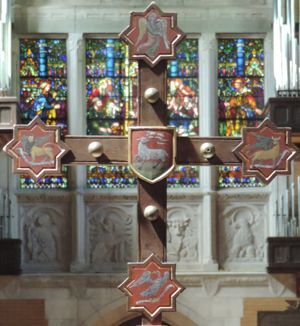Got A Question? Get An Answer
- ACCESSIBILITY
Q - In viewing the picture of the entrance to the new Parish House, it appears that there are steps but no hand rail or ramp for those who may require an assist. What allowances are being made for them?
A - There are ramps on both side of the steps. They “curve” up on either side of the steps. It’s difficult to see on the renderings, but rest assured that they are there. In fact, all of the new entrances will have ramps. All ramps will have easy automobile drive-up accessibility as well. The building will be fully accessible and once inside an elevator to access all levels.
- CONSTRUCTION AND DESIGN COSTS
Q - Yesterday I read that the Greek Orthodox shrine, a giant building next to the World Trade Center, has had construction halted because funds have at least temporarily run out. The article in the NYT caused me to wonder: In their case, the construction estimates nearly quadrupled in four years ($20 M in 2013, $72-78 M now) and I wonder what our escalation will be. Also, why does a gigantic space in super expensive downtown NYC "only" cost eight times what our much smaller space costs? It strikes me that $10M budget for a house would produce a much more elaborate building than the one we have planned. I don't dare to question the estimators on the project but I wonder about it. Maybe others do as well.
A - (Answered by Bob Nalls-architect and member of the Operating & Construction Committee.)
I am also often surprised by the cost of commercial construction compared to residential, but there are a number of significant differences. Because of the nature of its use, the Parish Hall is an Assembly Occupancy under the building code. This triggers a significant amount of construction and building system requirements that far exceed what is permitted for residential construction including elevator access, fire alarms and sprinklers, higher structural loads due to occupant loads, and stricter electrical standards to name a few. By way of example, the occupant load in the Assembly Hall alone would require more ventilation and cooling than my entire house. So, I agree that our budget would build quite a house, but not to the same standards.
I can’t address the comparison to the museum without considerably more data, but I can say that independent estimates have been prepared for our project by two different sources and are in close concurrence. In my own practice, I have to constantly remind myself to trust the data and avoid acting on rules of thumb such as square foot costs that seem to consistently get us into trouble. This is despite the sticker shock that we often face when we first review the estimates.
So in summary, there has been a significant value management effort supported by multiple cost estimates to assure that we have adequate budget without unnecessary or inappropriate spending. I am confident that the team will continue to seek appropriate opportunities for saving as the effort continues, but at this time the costs represent the best estimate of probable cost.
- FOOD SERVICE ON ALL LEVELS
Q - Any consideration of a kitchenette on each level so that food service can be accomplished more easily when meetings etc. are on floors other than the kitchen level?
A - (Answered by Ginger Woods-Design & Development and Operating Committee)
We have focused on making sure our new facility is as welcoming and hospitable as possible; it is a prime goal. And sharing food and drink at our get-togethers is an important of aspect of how we welcome. Of course supporting this can take different forms, with different costs associated, both for the build-out and for ongoing maintenance and clean up. The safety of the many outside groups who use the Parish Hall will also need to be evaluated as part of the decision-making process. Details will be worked out during Design Development by the Interior Designers, but there has already been much good input from our parish groups of over the last year.
Janitor’s closets with slop sinks are located on each of the floors to make all kinds of clean up easier and more efficient. For food service, the idea that every classroom/meeting area might be set up with coffee stations (Keurigs?) has been a popular one and would seem easy enough to implement. (Plumbing each room for sinks is currently not anticipated in the budget.) On the Main Level there is the Parish House Kitchen which now has much improved accessibility to all floors through more centrally-located stairs. If current facilities are imitated, there would be a kitchenette in the staff area, either on the Main or Upper Level. On the Lower Level, there has been active discussion of a kitchenette for the large Hospitality Center in the area currently occupied by the Thrift shop. Bathrooms are now planned for that space as well, so there is little added expense for plumbing and electrical to make a kitchenette there feasible, though it was not in the original cost estimates. Safety for outside groups using this area will also need to be considered, and, with the kitchen directly accessible above, a kitchenette there is still an open question. On the upper level, there is no kitchenette currently planned.
The detail of the fit-out will be worked out by the Interior Designers with continued input from various groups and users of the space, as well as staff. As the plan develops continual updates will be coming back to the Parish so that our most important priorities can be embodied in the design.
- FURNITURE STORAGE
Q - What plans are there for storage of tables and chairs? There should be dedicated storage spaces on every level so that the beautiful new building and elevator are not wrecked with the constant movement of tables, chairs, easels etc. Extra tables etc. are a lot cheaper than fixing the inevitable scratches and bumps from furniture movement.
A - (Answered by Jay Einspanier-Parish Administrator & Operating & Construction Committee)Good question and timely as well. We are still progressing through the "Design and Development" stage. As part of that stage, we have had talks specifically about storage for furniture and have a couple of options so far. I agree that without convenient storage, the tables and chairs will be simply stacked in the room(s) to provide easy access when the room or rooms are changed over for another meeting.
- I GAVE TO THE PREVIOUS CAMPAIGN
Q - I gave money to the last campaign that was supposed to be for both the church and the parish house. What happened to that campaign? Where is the remainder of the money raised? And why am I being asked to give again?
A - Yes, the original intent of the campaign in 2007 was to do the complete project (church and parish house). When the great recession hit, it was deemed wise to shut-down the campaign while still in the “quiet” phase when enough money had been raised to do the church project. The church project was completed and $2M was left over which remains in the bank for use in the parish house project. In hindsight, the time lapse between the projects has allowed our new rector and vestries to reexamine the parish house project and to develop a more significant plan that will meet Redeemer’s Parish House needs now and for the next generations. While those who pledged back in 2007 can feel a part of the parish house campaign, it is essentially a different campaign and, in fact, most of the pledges already received are from parishioners who gave and pledged in the previous campaign. It is most important that the opportunity to participate in the Legacy into Promise campaign is extended to all parishioners to feel ownership of this significant project.
- NAMETAGS
Q - Has anyone designed some space for the nametags? We have a very lousy system now: clips don't fit in retrofitted closet doors, and the whole thing is a mess. Our tags are issued only for the number of people that can fit on the boards, but the boards are a significant amount of square footage nonetheless. Any ideas from the designers?
A - Your request for a location and design of a system for the nametags has been forwarded to the Design & Development Committee and it is on the list for the interior designers when that work begins.
- PLEDGING AMOUNT SUGGESTION AND PAYMENTS
Q - What is the "standard" or minimal suggested donation? I thought I read somewhere we are being asked to pledge 3X our annual donation. Is that about right? And can you please explain how that can be paid over X years? Thank you!
A - (Answered by Tad Sperry--Campaign Gifts chair) Throughout the campaign we have been hoping that parishioners would make The Redeemer one of their philanthropic priorities. Our hope that would include Annual Giving which directly supports the operating budget, but also the capital campaign, Legacy into Promise. In conversations we have about gifts to the campaign we often speak of a “stretch” gift, something significant in the donor's life. It’s hard to quantify that level of generosity for any individual case. But, in the Full Participation Phase we have provided the guideline that 3 times your Annual Giving amount given over 4 years might be a good way to think about a gift to Legacy into Promise. We will provide a pledge form where the donor can specify how much they will be gifting in each year. Payment can be by check or we can accept appreciated stock, and instructions are available for that.
- PLEDGE FORM
Q - Can you please tell me where I can find the Legacy into Promise pledge form on the website? Is it posted?
A - The pledge form for the Legacy into Promise campaign is not yet available on the website. We've wanted to give our solicitors the opportunity to have personal conversations with parishioners about their pledge and then furnish them with a pledge form. If you would like to have a pledge form sent to you, please contact Ken Garner at ken@theredeemer.org.
- SHOWERS?
Q - Are there plans for shower facilities in our new parish house?
A - We have definitely included showers in individual men's and women's rooms as part of our lower level Outreach and Hospitality center. (Fomerly The Shop) There is also a washer dryer closet dedicated for that area. We thought having the showers as part of the hospitality suite, rather than separated down the hall with the public bathrooms was a more comfortable arrangement for any overnight guests. Our hope is that IHN and other outside groups will find us a hospitable resource and we can thus support many valuable programs in our community.
- SUSTAINABILITY
Q - I would like to know what if any elements for energy conservation and sustainability are incorporated in this large project. It behooves us, especially at this moment, to take our role as earth’s stewards seriously.
A - (Answered by our lead architect Christopher Miller.) Some of the energy conservation and sustainability aspects of the project can be summarized as follows:
1. While a geothermal system was ruled out for budget concerns, the selected variable refrigerant flow HVAC system is a very efficient system. The VRF system offers optimal zoning capabilities, with thermostats in each room and the ability to cool individual rooms while the remainder of the building is unoccupied at a higher set-point. This arrangement is ideal for a building such as the Parish House in which partial use is frequent. The VRF system will include a heat pump mode to provide heating as well as cooling, with the ability to simultaneously provide heating to unoccupied space while providing cooling to occupied spaces in the spring and fall. Supplemental heat will be provided by a hot water boiler system with radiators at the perimeter throughout the building, allowing the VRF system size to be reduced to the peak cooling load, as opposed to a larger system sized for the heating load.
2. Lighting fixtures will be selected with LED sources. In addition, lighting controls will be provided throughout the building to ensure that lights are not left on in spaces that are not occupied.
3. Plumbing fixtures will be selected as low-flow fixtures to conserve water.
4. The commitment to preserve, maintain and improve the use of the 19th-century historic Parish House in a sustainable way is significant. Some of the general aspects of the planning for the historic building and new addition that show a commitment to sustainability include the following: efficient and flexible use of existing space, and increased (and more efficient) use of space; creating significantly better connections to the outdoors, and increased use of exterior space; retention/recycling of existing fabric wherever possible; review of new materials and products for environmental impact (salvaged, recycled, rapidly-renewable, etc.); providing a well-insulated new building envelope and performing upgrades to the existing building envelope (energy panel installation at windows, added insulation, etc.) to reduce the load on the HVAC system; and emphasizing natural daylighting in the design of the new addition and through improvements to the existing Parish House.
I hope this helps to give you a sense of some of the aspects of the project that speak to the idea of sustainability.
Legacy Into Promise Campaign Form
Use this form to submit your questions about the Legacy into Promise campaign for our new Parish House.
These questions will form the basis for a growing page here where parishioners can visit to become more informed about the project.
Legacy Into Promise Campaign Form
We will get back to you as soon as possible.
Please try again later.
Contact Details
Mailing Address:
Church of the Redeemer
230 Pennswood Road
Bryn Mawr, PA 19010
Main phone number: 610-525-2486
Emergencies after hours: 610-526-0487

Send Us A Message
We will get back to you as soon as possible.
Please try again later.
All Rights Reserved | Church of The Redeemer


